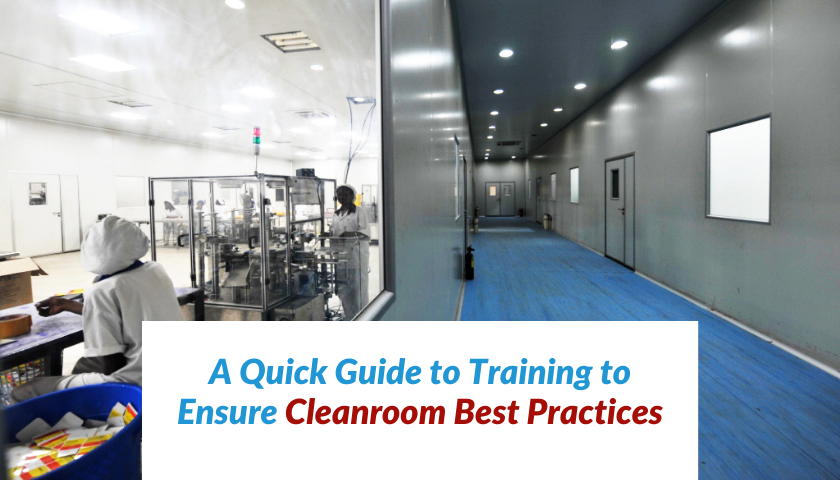A Quick Guide to Training to Ensure Cleanroom Best Practices

A run-up to the USFDA website will provide insights into the warning letters that are dispatched due to inadequate cleanroom sanitation measures. Last year, one of the companies that were dispatched a warning letter as they failed to follow appropriate procedures to prevent microbiological contamination of drug products implying to be sterile. It included validation of all aseptic and sterilisation processes that displayed poor aseptic practices by the operators. To elaborate, operators were placing their heads and upper torso inside the sterile-filling cabinets.
Apart from the long list of poor aseptic practices being displayed, other practices included a poor showcase of supplier qualification program, inadequate room design and smoke study deficiencies. Such deficiencies can affect the quality and sterility of the drug, thereby posing a threat to the end consumer. There are many instances of inadequate cleanroom sanitation. The FDA publishes them on their website.
All this emphasises on adequate information, knowledge and practical training during the onboarding process of a new employee, but how can it work for an amateur cleanroom operator enter the Cleanroom without know-how? Without training, by placing a new employee in a cleanroom laboratory for the first time, they may not have the faintest idea on how to operate in a cleanroom.
A quote by Aristotle is an appropriate fit here ‘For the things we have to learn before we can do them, we learn by doing them’. Every single time training is conducted, it begins with a plan to accomplish so that it is worthwhile for the employees and the organisation. Prior knowledge of the earlier training, any new or upgraded learnings, checking the material to be handed out to the employees are all crucial to training. Another crucial aspect while arranging the training is to understand who will be a part of the training sessions as it is equally important to reiterate training to the higher management or necessary people from various departments apart from the new joiners.
What should be included in the training?
Cleanroom contains equipment (Passbox, LAF workbench, Vertical LAF, Mobile LAF trolley etc) that is designed carefully and specifically for Cleanroom’s purpose, and the working protocols should be emphasised upon at the beginning of the orientation. Cleanroom working conditions pose hazards, and it is only crucial that the users understand and appreciate the rules and regulations not only to protect the Cleanrooms Infrastructure and Equipment but themselves too.
The training should incorporate:
- A text manual with written procedures that is handy and can be referred to during or after the training/orientation along with a good understanding of Good Manufacturing Practices
- Lectures by the Experts and Consultants taking them through
- the conception of cleanrooms and introduction to microorganisms and microbiological contamination management.
- the protocols and practices to be followed in the cleanrooms,
- materials used in Cleanrooms and
- Entry and Exit of Materials (through static and dynamic Passbox) and Personnel (Mist shower & Air shower) and working within the Cleanrooms
- Maintenance of the facility
- Practical Walkthroughs for Gowning practices: Gowning practices is essential to cleanrooms. The staff entering the Cleanroom needs to be trained for Gowning Procedures and Personal Hygiene Protocols. PPE kits must be worn at all time during hazardous work to safeguard self and cleanroom environment.
- Incorporate video lessons and latest developments in Cleanroom training like using simulation techniques and taking the trainees through virtual Cleanrooms that guides them through the process.
- Once learned, training should be reviewed to understand whether the process is well-understood by conducting a small quiz or test.
- Training methods should be visited often to check if they are effective, updated and not outdated.
Why should you conduct a Cleanroom Training?
Conducting a Cleanroom training helps
- understanding of correct gowning procedures and gowning and de-gowning in that particular
- create awareness and training lead to improved behaviour that helps avoid mishaps
- Improvement in auditing and assessing cleanroom procedures
- Being up to date and having a thorough understanding of the laws and regulations concerning your specific industry
Conclusion:
Cleanrooms are spaces with highly controlled temperature and humidity levels, and managing the microbial risk that can cause damage to product, be it Pharmaceutical, Biotechnology, Nanotechnology, Research, Semiconductors, Aeronautics and Defence, Food and Beverage or Cosmetics. The practice of unauthorised instruments, microorganisms and inadequate setting management are the most common causes of cleanroom contamination. Therefore for work needs to be carried out safely and effectively, following protocols as learnt during the training.
People are the main cause for contaminants during a cleanroom —therefore, the actions and measures taken are essential in maintaining room conditions. It is extremely necessary to follow all facility procedures for tasks like gowning cleaning, and chemical handling without adding self-improvisations.
Cleanrooms, therefore, continue to be the prime focus for regulatory inspections. Thus Pharmaceutical, Biotechnology, and Healthcare companies need to ensure that they have the training and regular internal reviews that are compliant with the country and regulatory laws.
Apart from conducting orientation, it is a must to include the following training to be effective: Personal Hygiene in Cleanroom a good understanding of microbiology learning and effective use of aseptic techniques for sterile work process, effective gowning use and methods, knowing about the current general manufacturing practices, movement within the Cleanroom etc.
Categories
Recent Posts
Subscribe
Never miss a post from Fabtech. Sign up to receive updates direct to your inbox.
